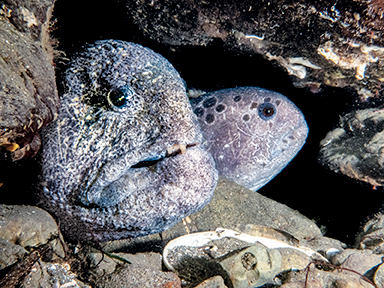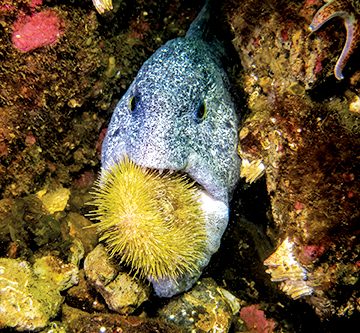ASK DIVERS IN THE PACIFIC NORTHWEST what makes for a great dive, and most will agree that a wolf-eel (Anarrhichthys ocellatus) is involved. There is something about the face of an adult wolf-eel staring at you from its den that turns an ordinary dive into a great one. The specific conditions don’t matter. Cold temperatures, terrible visibility, or strong currents are easy to forget when a wolfie — as we call them locally — appears.
It’s not surprising that divers worldwide travel far to glimpse these fascinating creatures and photographers go through all manner of underwater gyrations to capture the ideal shot.
Meet the Wolfie
People of the northern Pacific have deeply respected wolf-eels throughout history. Some native tribes reserved the wolf-eel as food for only shamans and healers. Although protected in Washington’s Puget Sound and Hood Canal, wolf-eels are not endangered, but their value to divers and photographers as a living resource far exceeds any commercial value as a food source.
Some dive sites, such as Sund Rock in Hood Canal, are well-known locations where wolf-eels interact with divers and provide unique photo opportunities. In the American Pacific Northwest and British Columbia, Canada, the prevailing attitude among divers regarding wolf-eels is affection and protection.
Although they have a long-bodied, eel-like appearance, wolfies are not related to eels but instead are a type of wolffish. They use their large frontal canine-like teeth and powerful jaws to seize and crush their favorite meals, primarily hard-shelled crustaceans and invertebrates based on their immediate environment, with the most abundant food source often being the most preferred. Wolf-eels in Puget Sound, for example, favor sea urchins and crabs; those near the northern Olympic Peninsula prefer the hairy triton snail; and those off Monterey, California, like sand dollars and the graceful crabs.
Wolf-eels typically grow to about 6 feet long — but can reach 8 feet — and weigh almost 30 pounds. They live as far south as San Diego, California, and northward up the Pacific coast to the Aleutian Islands in Alaska. No research is available on their longevity in the wild, but they live about 20 years in an aquarium setting.
They don’t have a swim bladder, the internal gas-filled organ most fish species have to help regulate their buoyancy and control their vertical position in the water column. The wolf-eel instead has evolved to rely on its muscular body and strong pectoral fins to maneuver and maintain its position in the water. The lack of a swim bladder allows them to lounge around on the bottom or in their home lairs.
Like snakes, they swim by making S shapes with their bodies and using their pectoral fins to steer. This unique adaptation allows them to thrive in rocky coastal habitats, where they can navigate through crevices and caves with exceptional agility. By forgoing a swim bladder, the wolf-eel has developed a specialized skill set that makes it an expert hunter.


Wolf-eels have a slimy coating on their bodies that serves several important purposes for their survival and protection. First, it acts as a natural defense against infections. The slime contains antibacterial and antimicrobial properties that help prevent the growth of harmful bacteria and parasites on their skin, reducing the risk of infection.
The slimy coating also makes it difficult for predators to grip or hold onto a wolf-eel. When threatened or attacked, wolf-eels can release more slime from their skin, making it even more challenging for predators to maintain a firm grip. This slippery defense mechanism allows them to escape from potential threats. The slimy layer also reduces friction when they move through the water, allowing them to easily pass through tight spaces and narrow cracks without getting stuck.
Life Cycle
Wolf-eels begin reproducing around age 7. Approximately 24 hours before mating, the female wolf-eel’s abdomen becomes noticeably distended. When this happens, the male will butt his head against the back of her abdominal region, which seems to stimulate physiological activity. A series of waves moves through the female’s body from her head to her tail, particularly pronounced in her abdominal area.
The male then wraps himself around the female so their heads are side by side and their genital regions are adjacent. In this position the female releases between 5,000 and 10,000 eggs, and the male fertilizes them as they appear. After fertilization, the female coils around the eggs, molding them into a ball-like cluster. The eggs adhere to each other but not to the den’s rocky walls. Both parents coil themselves around the egg mass, sometimes together and at other times individually. They tend the eggs, rotating them so a good water flow passes through them.
The eggs hatch after about 16 weeks, and the larvae float toward the upper part of the ocean or the sea. The tiny, 1.5-inch fish are born brownish pink but turn dark gray within a day and start snacking on small shrimp after a few days.
The larvae are on their own to swim with the plankton in the ocean for two years. They are voracious predators from birth and will strike at their planktonic prey, much like a coiled snake will strike at a mouse. Larval wolf-eels lead a pelagic existence in their constant search for prey. The maturing youngsters eventually settle on the ground and enter a den. Denning typically occurs in the Puget Sound area from February through April.
The shift to dwelling on the bottom triggers physical changes. Juveniles exhibit a vibrant and striking appearance, often becoming vivid orange or reddish orange with darker markings. This coloration helps juveniles blend in with their surroundings, such as rocky reefs or kelp forests. As they mature into adults, their coloration becomes a more subdued brown or reddish brown. The skin often has dark spots, which may be outlined in a lighter color. Males also develop a puffy face, enlarged jaws, huge bulbous lips, and a powerful sagittal crest at the top of their heads to support the increased muscle mass the jaws require.

Embracing a culinary adventure, a wolf-eel enjoys a green sea urchin.
Friends and Enemies
In the realm of a rocky reef, a fierce battle for ownership unfolds around desirable den sites. The key contenders in this contest are the giant Pacific octopus (Enteroctopus dofleini) and the fierce wolf-eel. Both species vie for control over these coveted shelters, which serve as their sanctuaries in a harsh underwater world. Their shared habitats, prey, and unyielding desire for the same type of den sites fuel this struggle.
With its unmatched dexterity and cunning, the octopus poses a formidable challenge. It ruthlessly evicts a wolf-eel, sometimes targeting mated pairs, and claims the den as its own. Despite the wolf-eel’s valiant efforts, there is little it can do once an octopus of even modest size has set its sights on a particular den.
Yet amid this cutthroat competition, surprising alliances emerge. Lingcods, another den-dwelling reef inhabitant, sometimes share crevices with wolf-eels. In a mysterious dance of coexistence, their egg masses are sometimes nestled close to one another.
The wolf-eels’ benevolent camaraderie doesn’t end there. Copper rockfish, brown rockfish, sailfin sculpins, and various shrimp species may also find solace within the wolf-eel’s den, forming a harmonious coexistence within the shelter’s confines.
Wolf-Eel Dive Encounters
Dropping into the Salish Sea’s cold waters is an experience like no other. A profound stillness envelops you as you plunge beneath the surface. The peaceful surroundings create an otherworldly atmosphere reminiscent of a lone explorer venturing into uncharted territory. Clutching the camera tightly in your hand, you can’t help but feel like a visitor from a distant planet as you venture deeper into the abyss.
You soon find yourself at the edge of a majestic wall that beckons you to explore its secrets. Moving gracefully beside it, you delve into its hidden recesses, curiously exploring every crack, crevice, and boulder. The vibrant marine life, seemingly painted by an artist’s hand, captures your attention at every turn. An unexpected encounter awaits as you immerse yourself in this underwater wonderland.
Out of the corner of your eye, a wolfie comes into view, fixated on your presence. Its curious gaze mirrors your fascination as if you share an unspoken connection in this captivating realm. The encounter sparks excitement, fueling your determination to capture this moment. With your camera poised and ready, you align the perfect shot, seizing the opportunity to immortalize this breathtaking encounter with this extraordinary creature. AD
© Alert Diver — Q4 2023